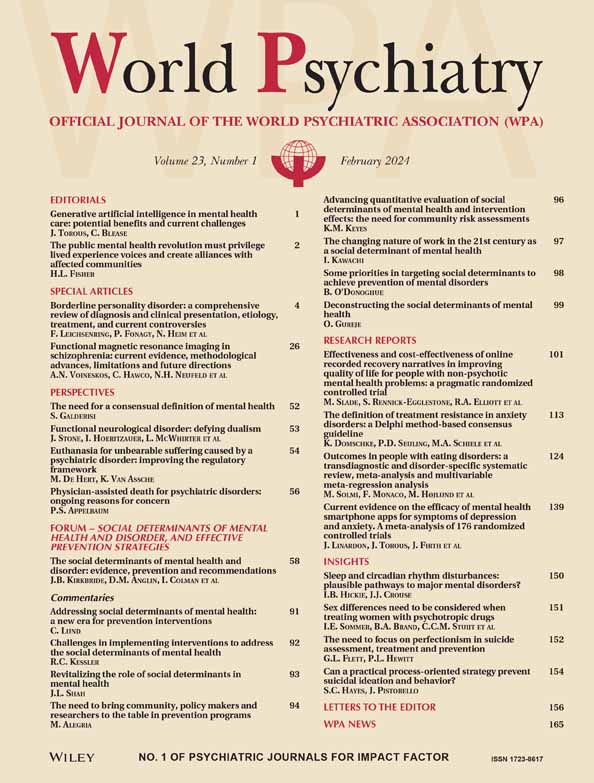Mental health care and treatment in prisons: a new paradigm to support best practice
IF 65.8
1区 医学
Q1 PSYCHIATRY
引用次数: 8
Abstract
R. Lovelace’s 17th century poem To Althea, from Prison alludes to the ability of a “quiet” mind to transcend the imposition implied by institutions which deprive people of their liberty. But our prisons are not full of “minds innocent and quiet”; rather they are overloaded by minds troubled by the experience of mental illness. There is a need to reach into prisons to address mental health needs, but “stone walls” and “iron bars” constitute barriers to this intent. Systems designed to care for and treat mental illness struggle in institutions designed to punish, deter and incapacitate. Yet people are sent to prison as punishment, not for punishment, which requires us to understand how humane treatment can be delivered in such environments. The existence of various international human rights instruments (such as the International Covenant on Civil and Political Rights, and the Convention against Torture and other Cruel, Inhuman or Degrading Treatment or Punishment) are necessary, but not sufficient by themselves, to ensure appropriate and humane care for some of the most vulnerable members of our citizenry. Worldwide more than 10 million people are held in penal institutions at any given time and more than 30 million people pass through prisons each year, with some regions experiencing prison growth well above population growth. There is an elevated risk of all-cause mortality, including suicide, for prisoners in custody and for ex-prisoners soon after release. We therefore have a collective interest in ensuring that health related need is identified and effective care is delivered during incarceration and the critical period of transition to community life. Research in this area has yielded increasing clarity about the central issues that need to be addressed to provide a comprehensive model of care for mentally unwell prisoners. First, the prison must screen for mental illness, at reception and at other critical times. At least five such screening instruments have been developed. However, additional triage and casefinding measures are needed to ensure comprehensive case identification. Once need is identified, hospital transfer may be required for the most unwell. Mental health legislation needs to accommodate such transfers. For others, prison-based care is often delivered through mental health in-reach teams, which have become increasingly systematic in creating care and treatment pathways for prisoners with serious mental illness, including contribution to release processes to enable sustained clinical involvement on release. Systems of prison mental health care are not bereft of innovation. Multi-disciplinary teams can address complex mental health and social care needs and include cultural expertise in jurisdictions where indigenous populations or ethnic minorities are over-represented in prisoner populations. Release planning constitutes an opportunity for “critical time intervention”, focusing on ensuring continuity of care across a range of providers as the prisoner transitions through the gate. The evidence for the success of such endeavours is gaining momentum, with indications of the positive impact of systematic prison in-reach models of care on detecting those requiring assistance and improving post-release engagement with mental health services. Modern prison outcomes are increasingly focused on reducing reoffending post release, and to this end we share a common purpose in the ultimate release of a rehabilitated prisoner whose mental health and addictions needs have been met. Yet, the pathway to this collective goal is far too often reliant on the goodwill of individual custodial staff or the ability of prison mental health in-reach teams to navigate the institutional barriers imposed when “safety and security” are prioritized over human suffering. Our social institutions are being challenged to re-think this siloed mentality. Whether change ultimately comes from legal challenges to human rights violations, or a pragmatic neoliberal emphasis on fiscal constraint, the shift is toward interagency collaboration. This is coupled with a person-centred approach with institutions re-focusing on the people they serve, rather than the self-perpetuating demands of the institution itself. In courts, such transformation is spear-headed by the principles of “therapeutic jurisprudence”, which invite legal systems to view their processes through a therapeutic lens. It is recognized that addictions, mental illness and social care needs (such as family support, housing and employment) are inextricably linked to rates of crime, to the extent that traditional adversarial courts have become revolving doors for offenders whose criminal behaviour arises from psychosocial challenges. The advent has been the proliferation of “solutionsfocused” courts, which use the leverage of the legal process to encourage people to address the causes of offending and actively involve social agencies that can assist. A paradigm shift is especially evident in youth justice custodial services. Research shows that justice-involved youth are exposed to high rates of trauma. Childhood physical, sexual and psychological abuse has negative consequences on subsequent life trajectories, leading to an increased likelihood of mental illness and ongoing involvement in the justice system. Under a trauma-informed model of care, young people are held accountable for their offending behaviour, but all parties involved recognize and respond to the impact of trauma on监狱中的心理健康护理和治疗:支持最佳实践的新模式
R.Lovelace 17世纪的诗歌《致阿尔西亚,来自监狱》暗示了一个“安静”的头脑有能力超越剥夺人们自由的制度所隐含的强加。但我们的监狱里并不是充满了“天真而安静的思想”;相反,他们被精神疾病的经历困扰着。有必要深入监狱以满足心理健康需求,但“石墙”和“铁棍”构成了这一意图的障碍。旨在照顾和治疗精神疾病的系统在旨在惩罚、威慑和丧失能力的机构中挣扎。然而,人们被送进监狱是为了惩罚,而不是为了惩罚,这要求我们了解如何在这种环境中提供人道待遇。各种国际人权文书(如《公民权利和政治权利国际公约》和《禁止酷刑和其他残忍、不人道或有辱人格的待遇或处罚公约》)的存在是必要的,但其本身并不足以确保对我国公民中一些最弱势的成员给予适当和人道的照顾。在世界范围内,任何时候都有1000多万人被关押在刑罚机构,每年有3000多万人通过监狱,一些地区的监狱增长远远超过人口增长。在押囚犯和获释后不久的前囚犯,包括自杀在内的全因死亡风险增加。因此,我们有共同的利益,确保在监禁和向社区生活过渡的关键时期确定与健康相关的需求,并提供有效的护理。这一领域的研究使人们越来越清楚地认识到需要解决的核心问题,以便为精神不适的囚犯提供全面的护理模式。首先,监狱必须在接待处和其他关键时刻对精神疾病进行筛查。至少已经开发了五种这样的筛查仪器。然而,还需要采取额外的分流和案件调查措施,以确保全面查明案件。一旦确定需要,最不舒服的人可能需要转院。心理健康立法需要适应这种转移。对其他人来说,监狱护理通常是通过心理健康外展团队提供的,这些团队在为患有严重精神疾病的囚犯创建护理和治疗途径方面变得越来越系统,包括为释放过程做出贡献,以使释放时能够持续的临床参与。监狱精神卫生保健系统并非缺乏创新。多学科团队可以满足复杂的心理健康和社会护理需求,并在囚犯群体中土著人口或少数民族比例过高的司法管辖区提供文化专业知识。释放计划是“关键时间干预”的机会,重点是确保囚犯通过大门时,一系列提供者的护理连续性。这种努力取得成功的证据越来越多,有迹象表明,系统的监狱内护理模式对发现需要援助的人和改善释放后与心理健康服务的接触产生了积极影响。现代监狱的结果越来越侧重于减少释放后的再犯,为此,我们有一个共同的目标,那就是最终释放一名精神健康和成瘾需求得到满足的康复囚犯。然而,实现这一集体目标的途径往往依赖于个别监管人员的善意,或者监狱心理健康联络小组在“安全和保障”优先于人类痛苦时克服体制障碍的能力。我们的社会机构正面临着重新思考这种孤立心态的挑战。无论变化最终来自对侵犯人权行为的法律挑战,还是务实的新自由主义对财政约束的强调,都是向机构间合作的转变。再加上以人为中心的方法,各机构重新关注他们所服务的人,而不是机构本身自我延续的要求。在法庭上,这种转变是以“治疗法学”原则为先导的,这些原则要求法律体系从治疗的角度看待其过程。人们认识到,成瘾、精神疾病和社会护理需求(如家庭支持、住房和就业)与犯罪率有着密不可分的联系,以至于传统的对抗性法庭已经成为罪犯的旋转门,因为罪犯的犯罪行为是由心理社会挑战引起的。“以解决方案为中心”的法院激增,它们利用法律程序的杠杆作用鼓励人们解决犯罪原因,并积极让可以提供帮助的社会机构参与进来。 青年司法拘留服务的模式转变尤其明显。研究表明,参与司法的年轻人遭受创伤的比率很高。儿童时期的身体、性和心理虐待对随后的生活轨迹产生了负面影响,导致精神疾病和持续参与司法系统的可能性增加。在创伤知情护理模式下,年轻人对自己的冒犯行为负责,但所有相关方都认识到创伤对
本文章由计算机程序翻译,如有差异,请以英文原文为准。
求助全文
约1分钟内获得全文
求助全文
来源期刊

World Psychiatry
医学-精神病学
自引率
7.40%
发文量
124
期刊介绍:
World Psychiatry is the official journal of the World Psychiatric Association. It is published in three issues per year.
The journal is sent free of charge to psychiatrists whose names and addresses are provided by WPA member societies and sections.
World Psychiatry is also freely accessible on Wiley Online Library and PubMed Central.
The main aim of World Psychiatry is to disseminate information on significant clinical, service, and research developments in the mental health field.
The journal aims to use a language that can be understood by the majority of mental health professionals worldwide.
 求助内容:
求助内容: 应助结果提醒方式:
应助结果提醒方式:


